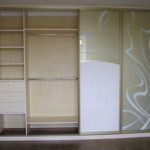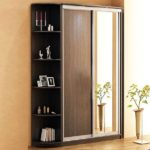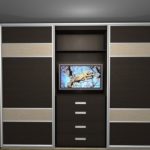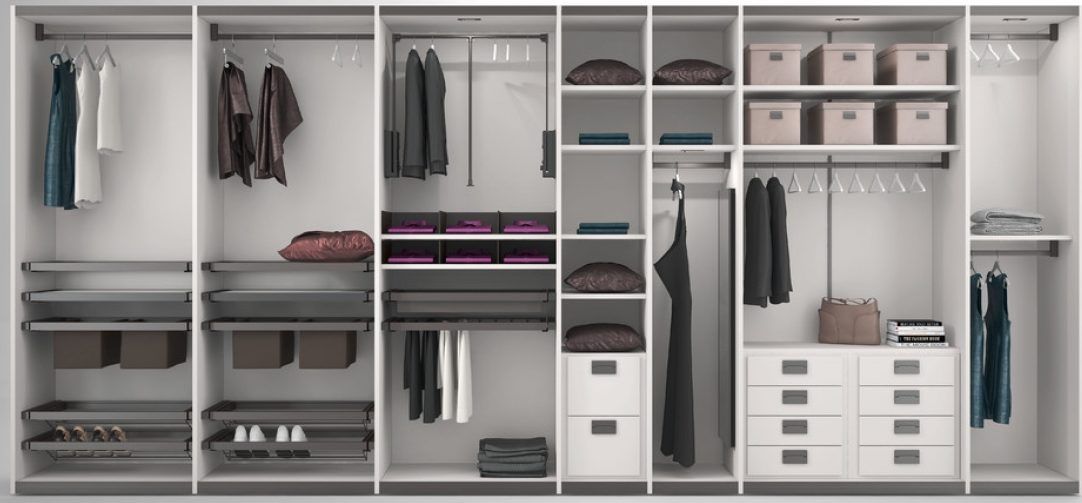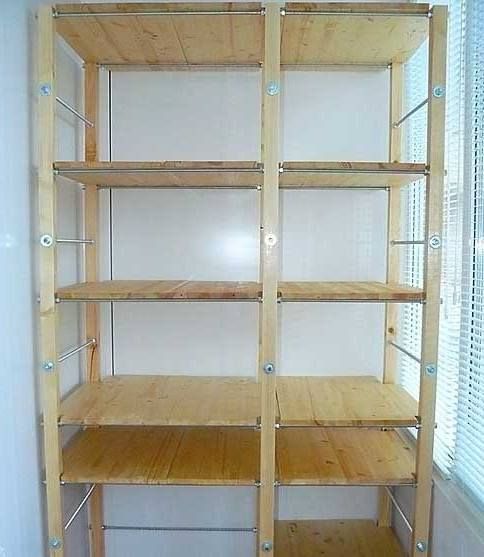How to assemble a wardrobe
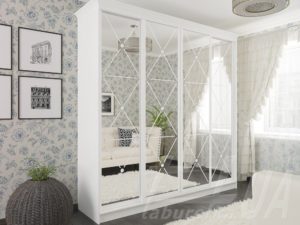 Assembling a wardrobe without the involvement of specialists is a way to significantly save the family budget. Knowing a few simple rules will make the task easier, which even those who have never carried out such work before can cope with.
Assembling a wardrobe without the involvement of specialists is a way to significantly save the family budget. Knowing a few simple rules will make the task easier, which even those who have never carried out such work before can cope with.
The content of the article
How to assemble a wardrobe
Before you start assembling furniture with your own hands, you should unpack the structural elements and sort them into groups:
- bottom and top;
- side walls and internal partitions;
- shelves;
- composite shells;
- accessories.
ATTENTION! The back wall and doors are put aside at this stage, since they take up a lot of space, and their turn will come only at the last stages of installation.
By fittings we mean:
- fastening elements: self-tapping screws, dowels, confirmatory screws and/or minifixes (eccentric ties);
- handles for drawers and cabinet legs, if a particular model should have them;
- rod (pipe for trempels) with holders;
- guides for doors and cabinets;
- hangers;
- other small elements, if they are provided for by the features of the purchased cabinet model.
Required Tools
Often complete with confirmations there is a hexagon with which furniture is assembled. But this key is not all that you may need. After all, control measurements need to be carried out with something, and the structural elements need to be tapped so that they fit tightly to each other at the points of connection with dowels. In order not to waste time searching for the necessary tools later, you need to prepare:
- roulette;
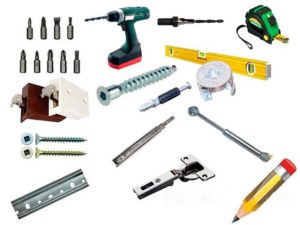
- level;
- drill;
- rubber and regular hammers;
- flat and Phillips screwdrivers;
- L-shaped hexagon.
The drill will be useful at least when installing the rod. Using a rubber hammer, you can adjust structural elements without fear of damaging their outer coating. If you don’t have such a tool, you can use a regular one. But in this case, you will need a shock-absorbing lining to prevent metal contact with the laminate.
It’s better to forget about a screwdriver while assembling large-sized furniture: it’s easy to “miss” with it by screwing in a screw deeper than necessary. And this can lead to a decrease in the strength of the entire structure due to weakening of the attachment points.
Stages of assembling a sliding wardrobe
Such furniture is assembled according to the “bottom up” principle. After all, the heavier a part of the structure, the more difficult it is to lift it for installation on other elements. The second rule is to assemble only vertically. Some experts recommend assembling the cabinet on the floor, and only then lifting and installing, but this method has many disadvantages:
- It is necessary to take into account the diagonal of the side wall: if it is equal to or greater than the height of the room, then it will not be possible to raise the compartment. The minimum difference is 5 cm.
- It is difficult to avoid distortions, because there is no way to identify them in a timely manner using a level.
- After lifting the structure, it is necessary to re-check and tighten all fasteners, getting rid of any play.
The only advantage of this method is that you can cope with the task without outside help. But vertical assembly is also easy to do alone if you know a few secrets and follow the instructions.
Assembling the lower part and frame
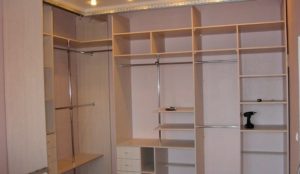 The first and most important stage of assembling the cabinet is the correct connection of the bottom elements. This part differs from the lid in the large number of holes, some of which may be through. Another difference is that there are places for fastenings on both planes of the workpiece. You can determine where the bottom side of the part is by looking at the cabinet diagram: the holes in the area of the partitions indicate that this is the top.
The first and most important stage of assembling the cabinet is the correct connection of the bottom elements. This part differs from the lid in the large number of holes, some of which may be through. Another difference is that there are places for fastenings on both planes of the workpiece. You can determine where the bottom side of the part is by looking at the cabinet diagram: the holes in the area of the partitions indicate that this is the top.
There are three options for the supports:
- legs;
- base;
- combined - a combination of the previous two.
Depending on what is provided for a particular coupe model, the mounting system may differ. The base is usually fixed using dowels and confirmations. In this case, wooden plugs are first driven into the footboard, then the part is connected to the bottom, and only after that the screws are screwed in.
Cabinet legs can also be attached in different ways. If fixation is provided using confirmations and self-tapping screws, then first you need to screw in the central fastener, and then additional ones. For models with a combined support, the legs are installed first, after which the base is installed.
Installing sidewalls and internal partitions
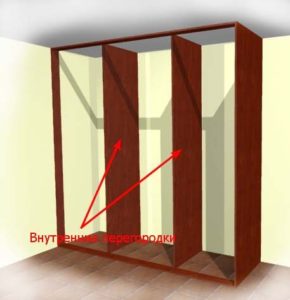 When the support is ready, the turn of the most labor-intensive process comes, which is difficult for a novice master to cope with alone. But there is a way out. Just take a closer look at the attachment points of the sidewalls to the bottom. If the walls are placed above the base plate, then assembly can begin according to the “edge to edge” principle.If on the sides, the direction of installation of partitions and sidewalls will be from the center to the edge.
When the support is ready, the turn of the most labor-intensive process comes, which is difficult for a novice master to cope with alone. But there is a way out. Just take a closer look at the attachment points of the sidewalls to the bottom. If the walls are placed above the base plate, then assembly can begin according to the “edge to edge” principle.If on the sides, the direction of installation of partitions and sidewalls will be from the center to the edge.
Having decided on the order of connecting the elements, lay out two nearby (reference to the diagram) verticals and the corresponding shelves on the floor.
REFERENCE! If the furniture is of high quality, then it has a duplicate connection: dowels and confirmations or minifixes. This makes the cabinet more durable; its shelves do not break at the fixation points under the weight of things.
Next, the dowels are driven into the sidewalls of the shelves, with the help of which the verticals are then connected - a sidewall and a partition or two partitions. At this stage, it is important not to confuse the front and back ends. It's easy to distinguish: the front one has a decorative coating.
The resulting structure is lifted and placed on the bottom. The shelves serve as spacers to prevent the partitions from falling, so you can safely continue assembling the cabinet without outside help. Subsequent work is carried out according to the same principle: a dowel into the shelf, which is then placed on the partition and connected to the finished part of the structure.
The final stage is to achieve complete fit of the parts using a rubber hammer and control fixation of the fastening points with confirmations or minifixes.
Cabinet cover
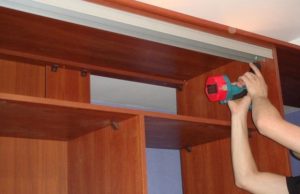 This part can be attached to the walls from above or from the side. In the first case, it is recommended to insert connecting elements into the fastening points, then place the sheet upward and tighten the screws. The second option involves the reverse procedure: the cover is first installed in place and then secured with fasteners.
This part can be attached to the walls from above or from the side. In the first case, it is recommended to insert connecting elements into the fastening points, then place the sheet upward and tighten the screws. The second option involves the reverse procedure: the cover is first installed in place and then secured with fasteners.
Before tightening the confirmations, you should use a tape measure to make sure that the cabinet frame is assembled correctly. To do this, measure both of its diagonals. If they are the same, then everything is fine.When one is larger than the other, there is a distortion that must be eliminated before fixing the lid. This is done simply: the cabinet is supported from the side of the slope, after which all the fastenings that are loose are tightened.
Back wall
Depending on the size of the compartment, its back side may consist of one or several sheets of fiberboard. In the first case, everything is a little simpler: the fiberboard is fixed in the corners of the cabinet, and then attached to all its elements.
If the furniture is large, then connecting strips are attached to the fiberboard sheets. In this case, it is recommended to assemble from the bottom up. The bottom sheets are attached first, which are then secured with a vertical bar. Then the top fiberboard and horizontal connector.
IMPORTANT! The strength of the cabinet depends on the correct installation of the rear wall. Therefore, you should not save nails - the sheet is nailed to all partitions and shelves of the compartment.
We fasten the guides
The lower rail consists of two grooves for the movement of the rollers, the upper one looks like a profile with a central divider. If they do not have holes for fastenings, then you will have to make them yourself. In the lower rail they are located in the center, in the upper - in a checkerboard pattern.
IMPORTANT! When drilling, do not forget about the chamfer, designed to deepen the screw head flush with the rest of the blade.
The top bar is placed so that its front part coincides with the front edge of the cabinet lid. When installing the lower edge of the compartment slab, an indent of 10–15 mm is made. This is necessary in order to avoid distortion and ensure smooth movement of the doors. One more thing: before installing the bottom guide, you need to insert stoppers into its grooves.
Fastening wardrobe doors
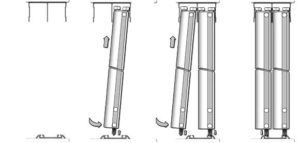 This is one of the simplest and at the same time important stages: often the door leaf is made of expensive and fragile materials. Before hanging the doors, the doors are unpacked and laid out to determine the order of their installation - it depends on the design. Then take the one that will be installed on the inner rail and insert it into the upper groove. After this, the wheel is pressed out and the door is fixed on the lower guide. Then the actions are repeated with the external ones and the assembly is completed.
This is one of the simplest and at the same time important stages: often the door leaf is made of expensive and fragile materials. Before hanging the doors, the doors are unpacked and laid out to determine the order of their installation - it depends on the design. Then take the one that will be installed on the inner rail and insert it into the upper groove. After this, the wheel is pressed out and the door is fixed on the lower guide. Then the actions are repeated with the external ones and the assembly is completed.

